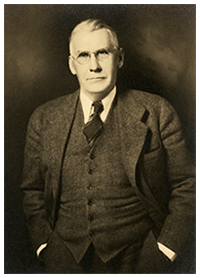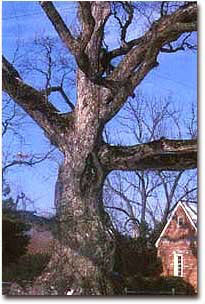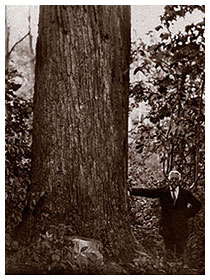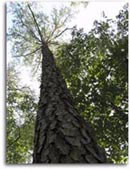National Big Tree Contest Started Here
By Champ Zumbrun
 The roots of the Big Tree Contest are planted in Maryland, for it all started in “the Old Line State” in 1925. Fred W. Besley is the founding father of the National Big Tree Champion Contest.
The roots of the Big Tree Contest are planted in Maryland, for it all started in “the Old Line State” in 1925. Fred W. Besley is the founding father of the National Big Tree Champion Contest.
Besley served as Maryland’s first State Forester during the period of 1906-1942. The chief forester was also a member of the Maryland Forestry Association (MFA) , which sponsored the contest. Ninety years ago, MFA’s expressed goal of the competition was “to obtain a complete description and registration of all the beautiful trees of the state. It is hoped to obtain the historical and distinguishing characteristics of the most important trees of the state.”
The competition was launched on April 27, 1925 at the beginning National Forest Week. The MFA offered seventy-five dollars in prizes, first, $25; second, $20; third, $15; fourth, $10; and fifth, $5.
The deadline for the first big tree contest was supposed to end on July 1, 1925, but due to so many last minute entries was extended to July 20. With the exception of one county, all counties participated in the event.
 Remarkably the State Forester agreed to travel throughout the entire state to personally inspect all the trees in the prize-winning classes and take official measurements and photographs. Many of these photographs still survive as glass lanternslides and are stored at the Maryland State Archives in Annapolis.
Remarkably the State Forester agreed to travel throughout the entire state to personally inspect all the trees in the prize-winning classes and take official measurements and photographs. Many of these photographs still survive as glass lanternslides and are stored at the Maryland State Archives in Annapolis.
In his booklet, Big Tree Champions of Maryland: A Record of the Largest Trees of the Principal Species, printed in 1956, Besley discussed the birth of the Big Tree Contest. He wrote that the forests of Maryland were rich in different kinds of trees, “probably more than 250 native tree species, and there was a universal interest in notable trees. Besley was inspired “to organize a Big Tree program in which would be collected measurements and photographs of the distinguished trees of Maryland.” It appears that until 1925, Besley worked alone on this project.
“By 1925, the interest in large trees and noted trees had so increased,” Besley wrote, “that the Maryland Forestry Association sponsored a state-wide Big Tree Contest. Prizes were offered, rules were adopted, and wide publicity given to secure as many entries as possible. Each tree species was classified separately so that species like dogwood and persimmon would not have to compete with such larger trees as oaks and elms.”
 Besley developed the method of measuring big trees that was adopted by the American Forestry Association, with only some slight modifications.
Besley developed the method of measuring big trees that was adopted by the American Forestry Association, with only some slight modifications.
Besley wrote about this: “At this time [early 1900’s] there were no standard measurements of trees, so it was necessary to draw up standards to insure fair comparisons. The author devised the following standards. To qualify as a tree, the specimen must have a single stem or trunk for at least 4 ½ feet above the ground level and a total height of 15 feet.” Besley’s method took three important measurements involving the trunk circumference, crown spread, and height of a tree.
In the first statewide Maryland Big Tree Champion Contest of 1925, Besley notes that 450 entries representing more than 57 species were received. Besley acted as “umpire in measuring those [trees that] appeared to be competitors in the prize winning class.” After all was said and done, the first Maryland Big Tree Champion list contained 155 species, among them the Wye Oak, the largest white oak ever recorded. In 1937, this list was revised and published.
We learn in the book - Wye Oak: The History of a Great Tree by Dickson J. Preston - that Fred W. Besley was behind the efforts to expand the Maryland Big Tree Contest to a national level. Preston writes the following: “…in 1940, he [Besley] suggested to the American Forestry Association (of which he was by now a senior member of the board) a means of putting the Wye Oak and other declared [Maryland] national  champions to the test. His proposal was a national contest along the lines he had been conducting in Maryland. Readers of American Forests…would be invited to send in measurements of trees they thought should be national champions, and the winner would be chosen by the Besley system of measurement.”
champions to the test. His proposal was a national contest along the lines he had been conducting in Maryland. Readers of American Forests…would be invited to send in measurements of trees they thought should be national champions, and the winner would be chosen by the Besley system of measurement.”
So, when you locate and nominate a big tree candidate you carry on a legacy started in Maryland by Fred W. Besley. Indeed, this effort is a noble cause, for the purpose of the Big Tree Contest is the same as announced in the first National Big Tree Champion contest held in 1940: “…to locate ‘the largest living specimens of American trees and focus attention on the benefits of conserving these cherished landmarks.’”
Photographs (top to bottom)
- Fred W. Besley, Maryland’s first State Forester (1906 -1942) and father of the Big Tree Champion Program. Photograph courtesy of Helen Besley Overington
- Maryland's Wye Oak, National White Oak Champion before it's fall in 2002.
- 1925 Maryland Champion Big Tree Candidate, photo by Fred W. Besley
Sources:
- Contest Arranged for National Forest Week: $75 in Prizes are to be Awarded for Registration of Fine tree Specimens. (1925, April 27). The News (Frederick County, MD), p. 3.
- The Tree Contest. (1925, August 22). Denton Journal (Denton, Maryland), p. 5. (Note : this article states that 312 trees were entered for prizes, but several years later Besley mentioned in his Big Tree publication that there were 450 tree entries. I went with the State Forester’s personal account of the contest).
- Zumbrun, Champ. (2010). A History of Green Ridge State Forest. Charleston, SC: History Press. pp.100-102
Back to Feature Stories